|
Motion Computing F5v
Motion Computing provides a major performance increase and a wealth of productivity-boosting enhancements to its innovative rugged Motion F5 tablet
(by Conrad H. Blickenstorfer, photography by Carol Cotton -- view PDF version)
This is a first hands-on look at the 2010 edition of Motion Computing's F5 tablet computer, now named F5v, which Motion calls a "rugged, portable, mobile field tool that integrates technologies to optimize workflow for mobile field professionals." The F5 is a companion version of Motion's milestone C5 Mobile Clinical Assistant that is based on Intel's clinical computing platform reference design.
While the slender square tablet form factor with integrated handle was originally conceived for healthcare staff that would benefit from a lightweight design with barcode scanner built into the handle, the design is equally suitable for work outdoors. This even more so as the handy platform from the start came with a sturdy Magnesium-alloy internal frame, a tough resin upper faceplate and lower backplate, and elastomer overmolding that made it not only easy to hold and handle, but also shock and scratch-resistant. Add to that IP54 sealing and it's clear why Motion decided to expand the platform's range. For our detailed review of the original Motion F5, click here. Our 2009 update is here. In this article we're reporting on the vastly more powerful 2010 F5v version of the product, and how it compares to earlier versions.
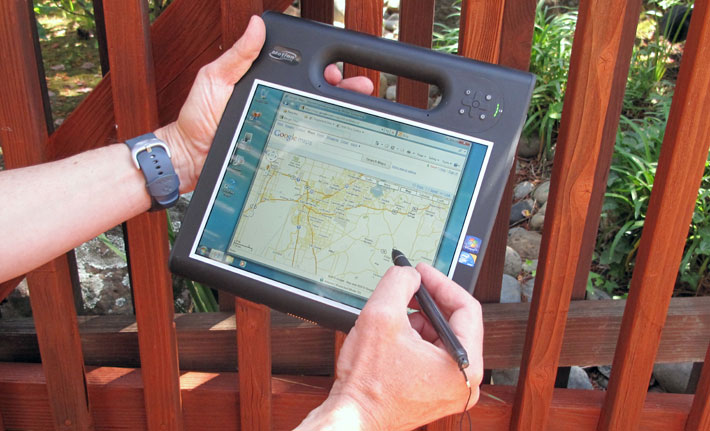
One thing that has set Motion Computing apart ever since the company entered the tablet market in 2002 is their resolve to quickly make available to their customers the latest technological developments. Motion users never had to wait long to find the latest and processors and display technologies available to them, and Motion never compromised in any way. When a lot of the competition jumped on the Intel Atom platform, Motion stuck with more powerful (and more expensive) Core processors, and sprung for the absolute best display technology (Hydis ASSF+) with virtually unbreakable displays (courtesy of Corning Gorilla glass).
So what does the latest version of the Motion F5 offer? First and foremost a switch from an already class-leading Intel Core 2 Duo U7500 to Intel's latest and "best" Core i7 that provides totally unprecedented power in a lightweight tablet computer. Second, a number of much appreciated technology and functionality enhancements such as dual cameras, an onboard USB port, Gobi 2000, speedy 802.11n WiFi, a hot swappable battery and more.
Intel Core i7 power
So what's the big deal with the switch to the Intel Core i7 processor? Well, while in the past, new Intel processors did not always deliver the promised performance boosts, the new Core processors do, and then some. Here's what happened: After several years of Core Duos and Core 2 Duos, in early 2010, a new generation of Intel Core processors was released to provide better performance, better integration, newer technology, and higher efficiency.  The new Core i3, Core i5 and Core i7 processors by and large represent Intel's "good," "better," and "best" processor solutions in any given category. It gets a bit confusing as the new processors come in numerous versions at different speeds and including different technologies. Core i3 processors, for example, do not have the new Intel "Turbo Boost" feature that provides extra performance via automatic overclocking. Core i7 processors generally have more cache and support more special Intel features than Core i5 and Core i3 processors. Also, as a first in this class of Intel processors, the memory controller and fairly powerful integrated graphics with HD hardware acceleration are now part of many of the the processors, and there are new and more powerful companion chipsets. The new Core i3, Core i5 and Core i7 processors by and large represent Intel's "good," "better," and "best" processor solutions in any given category. It gets a bit confusing as the new processors come in numerous versions at different speeds and including different technologies. Core i3 processors, for example, do not have the new Intel "Turbo Boost" feature that provides extra performance via automatic overclocking. Core i7 processors generally have more cache and support more special Intel features than Core i5 and Core i3 processors. Also, as a first in this class of Intel processors, the memory controller and fairly powerful integrated graphics with HD hardware acceleration are now part of many of the the processors, and there are new and more powerful companion chipsets.
How does all of this apply to Motion and the new F5v tablet? In terms of processing power, the C5 and then F5 began with lowly 1.2GHz Intel Core Solo U1400 single core processors. That chip was then replaced by the Intel Core 2 Solo U2200 that ran at the same 1.2GHz clock speed, offering incrementally better performance. That was around the time when a lot of the competition began experimenting with Intel Atom processors that cost less, but offer only modest performance that's roughly at the early Core Solo level. Motion rejected that path and switched to the far more powerful Core 2 Duo U7500 processor, resulting in a substantial power boost at just a slight reduction in battery life. Just a year later, Motion has now switched to an Intel Core i7 640UM processor. This CPU runs at 1.2GHz but can reach as much as 2.266GHz when Turbo Boost kicks in, and it is, for now, one of just two ultra-low voltage i7 processors. This is a highly sophisticated, powerful processor with over a dozen new and/or improved Intel technologies. But first things first: How fast is the new F5v with it?
Speed in computers is relative. Operating systems and systems configurations can have a greater impact on perceived performance than processors. But benchmarks are still a good way to test performance. So we ran Passmark Software's PerformanceTest 6.1 on the F5 to objectively measure performance. Passmark's benchmark suite runs about 30 tests covering CPU, 2D graphics, 3D graphics, memory, and disk and then computes scores for each category and an overall PassMark score. For comparison, we're showing the numbers of the first generation F5 with its Core Solo processor and the new machine's predecessor with its 1.06GHz Core 2 Duo U7500. We're also including the figures of the Panasonic H1/H1 Field which comes with a high-end Atom processor, and throw in reference benchmarks for Intel Atom N270-based systems. The N270 can be found in millions of netbooks and also some vertical market tablets. The results are as follows:
|
PERFORMANCE COMPARISON
|
Motion F5v 2010
|
Motion F5 2009
|
Motion F5 original
|
Panasonic H1 Field
|
Atom N270 reference
|
|
Processor
|
Intel Core i7 640UM
|
Intel Core 2 Duo U7500
|
Intel Core Solo U1400
|
Intel Atom Z540
|
Intel Atom N270
|
|
OS
|
Windows 7
|
Windows 7
|
Windows XP
|
Windows XP
|
XP Embedded
|
|
Clock Speed
|
1.20GHz
|
1.06GHz
|
1.20GHz
|
1.86GHz
|
1.60GHz
|
|
Thermal Design Power (TDP)
|
18.0 watts
|
10.0 watts
|
5.5 watts
|
2.4 watts
|
2.5 watts
|
|
CPU Mark
|
781.4
|
389.8
|
324.9
|
275.4
|
321.1
|
|
2D Graphics Mark
|
184.6
|
86.9
|
153.8
|
115.7
|
192.5
|
|
Memory Mark
|
496.1
|
202.7
|
235.1
|
242.7
|
199.1
|
|
Disk Mark
|
1040.2
|
435.5
|
168.8
|
282.8
|
74.6
|
|
3D Graphics Mark
|
256.0
|
85.6
|
75.6
|
10.1
|
71.5
|
|
Overall PassMark
|
564.9
|
251.3
|
194.4
|
191.9
|
190.7
|
|
CrystalMark ALU
|
23147
|
8141
|
4565
|
6149
|
5413
|
|
CrystalMark FPU
|
23596
|
8080
|
5343
|
5414
|
4726
|
|
CrystalMark MEM
|
16552
|
6222
|
4989
|
4327
|
4172
|
|
CrystalMark HDD
|
24780
|
15444
|
3252
|
5156
|
2676
|
|
CrystalMark GDI
|
6978
|
1388
|
4239
|
1202
|
2239
|
|
CrystalMark D2D
|
1492
|
1542
|
4221
|
187
|
2180
|
|
CrystalMark OGL
|
1617
|
861
|
1151
|
400
|
704
|
Overall CrystalMark
|
98162
|
41678
|
27760
|
22835
|
22110
|
Results of benchmarks are rarely conclusive, and tests run on dissimilar systems architectures and storage types often yield results that do not seem to fit. However, this time, the results are very clear:
The new Motion F5 with its Intel Core i7 processor is much, much faster than the predecessor machines.
The major improvements are in the processing, disk, and memory areas, with graphics performance also improved, but subjectively not by as much. Overall, in RuggedPCReview's benchmark testing, the new Motion F5v has roughly 2.2x performance compared to the 2009 Core 2 Duo machine, and about 3 to 3.5x performance compared to the original Core Solo version. It also easily runs rings around any Atom-based device.
(Here I should mention that the new Motion F5 will also be available with the Intel Core i5-520UM, a slightly slower chip (1.066GHz base clock speed, 1.866GHz Turbo Boost max) with the same thermal design power and, with the exception of a smaller smart cache (3 instead of 4MB), the same features.)
But how about power consumption and battery life? This seemed a concern as the original Core Solo had a thermal design power of just 5.5 watts, the 2009 model's Core 2 Duo U7500 a TDP of 10 watts, but the new chip is rated at 18 watts! While TDP has more than tripled, the new F5 still has the same modestly sized battery as the original C5 that wasn't designed to ever be far from a charging station or dock. Given the much higher TDP of the new F5's Core i7 chip, how much battery life can one expect from the new F5?
We ran the Passmark BatteryMon benchmark to check power draw and the results are as follows:
|
PERFORMANCE COMPARISON
|
Motion F5v 2010
|
Motion F5 2009
|
Motion F5 original
|
|
Observed Power Draw
|
10.90 watts
|
12.40 watts
|
10.70 watts
|
Projected Battery Life
|
3.94 hours
|
3.33 hours
|
3.86 hours
|
The results are amazing. The new, and vastly more powerful machine, uses no more power than the original Core Solo version of the F5. And it uses 12% less power than the predecessor F5 with the U7500 chip! As with any benchmark results, of course, your own mileage may vary. What seems indisputable is that the new Intel Core i3/i5/i7 processors, despite their relatively high thermal design power numbers, are exceptionally frugal. Based on our experience, Windows 7, with its much improved standby and resume features, also greatly contributes to better power management.
Overall, these benchmarks confirm what we felt when using the new F5v: it is much faster than the older machine, but it doesn't use more battery. Motion's internal testing (which we've always found conservative), yielded a 50% performance improvement and a 30% increase in battery life. We feel the machine is faster yet, though our battery life testing is a bit behind Motion's.
Battery now hot-swappable!
Knowing that there will be times when the F5's 44 watt-hour battery will have to be swapped in the field, Motion added a hot-swap feature to the new F5. An internal backup battery gives you about a minute to replace the spent battery with a freshly charged one. If you miss the window, the F5 automatically goes into hibernation and then simply resumes when it's either plugged in or has a new charged battery inserted. Hibernation, by the way, is much less cumbersome under Windows 7 than ever before: the screen just winks out, and then operation resumes when power is back.
Superior display technology
Last year, Motion announced that the C5 and F5 tablets would get Hydis AFFS+ (Advanced Fringe Field Switching) displays as a standard feature, and the F5v has it, too. Hydis AFFS technology offers a full 180-degree viewing angle from all directions and there are none of the annoying color shifts and variations in luminance you often still see in conventional LCDs. AFFS+ adds reflective areas to what is essentially a transmissive design, and also adds special polarizers and cell design optimized to reduce surface reflectance. 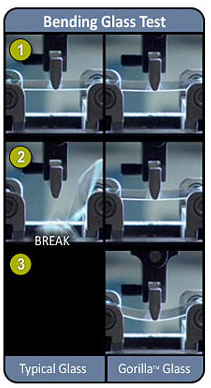 As a result, AFFS+ screens are bright and vibrant indoors while being amazingly vibrant and readable outdoors, combining the best of both worlds better than any of the older transflective displays can. As a result, AFFS+ screens are bright and vibrant indoors while being amazingly vibrant and readable outdoors, combining the best of both worlds better than any of the older transflective displays can.
In October 2009, Motion made another announcement: Corning's somewhat funkily named "Gorilla glass" was now optionally available. With the new F5v, Gorilla glass is now standard. What is Gorilla glass? According to Motion, "thin-sheet glass that was designed to protect against real-world events that cause display damage." Examine some of the video on Corning's Gorilla Glass page, and you see the glass being bent and steel balls falling onto it. The glass neither shatters nor breaks. In fact, it's hard to believe it's glass at all. It looks more like a very thin sheet of some polycarbonate plastic or acrylic. But it is glass.
The secret, according to Corning's Dr. Shashidhar, lies in a special chemical ion-exchange strengthening process that results in what Corning calls a "compression layer" on the surface of the glass. The primary purpose of that layer is to act as an armor that guards against the nicks and tiny cracks that then result in the glass breaking. And even if there are tiny nicks, the layer keeps them from propagating.
Gorilla Glass adds peace of mind because you just know it won't break. And Gorilla Glass has another benefit that may turn out to be quite a selling point for Motion: it's nearly immune to smudges. There's nothing worse than a display that's full of grime and fingerprints, and that just doesn't seem to be an issue with Gorilla Glass.
I don't think the latest Motion F5v has additional changes in the display, but as long as we had the new machine in our test lab, we decided to do some side-by-side comparisons with an original F5 (gray housing).
The first picture shows the older F5 (gray housing) and new 2010 F5v model (black housing) side by side outdoors, facing away from the sun. It's clearly noticeable that, at full brightness, the new display is considerably brighter. That can make a difference in readability.
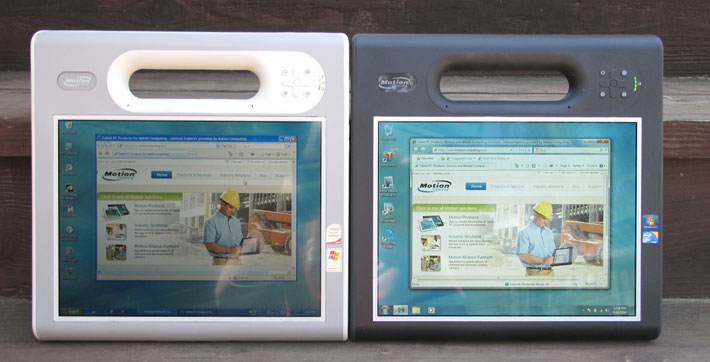
The comparison shots below show the machines in bright daylight, but in a shaded setting. The shots again show the brightness advantage of the new display. They also show that both displays control screen reflections fairly well, with the old one having more anti-glare treatment. Anti-glare is a mixed blessing as it often simply diffuses light, making the display milky and unreadable. Both displays have a glossy surface, but the display treatment is clearly different. "Glossy" screens usually "pop" more, but their sharp reflections can mess with our brains that have a tendency to fill in missing detail so that it becomes more difficult to concentrate on what is actually on the display.

The picture below shows macro excerpts of each display from an earlier face-off between AFFS+ and the original display technology used in the F5. There is a surprisingly large difference in color, vibrancy and perceived resolution. Although both screens had XGA resolution, the new display looks much crisper and sharper. This probably accounts for the overall crisper and brighter appearance of the new AFFS+ display.

As stated above, the latest F5 display is much easier to wipe clean and it's significantly less prone to fingerprints and other smudges, to the extent where it is virtually immune to those annoyances. This seems like a small thing but it's not. On the old screen, wiping off a simple fingerprint often seemed impossible. On the new one, it just wipes off.
Other changes and improvements
Technology never stands still, and so Motion took the opportunity to upgrade the new F5v to the latest status. Here's what has changed in addition to the Core i7 processor, the hot-swappable battery, and the standard Gorilla glass:
The unit can now be ordered with Gobi 2000 integrated WWAN. Gobi stands for Global Mobile Internet technology, and is a Qualcomm wireless technology that supports the various wireless networking technologies around the world, so users can select whatever carrier is available to them (see Qualcomm page on Gobi). Gobi 2000, in addition to current wireless technologies, also supports emerging 4G standards.
- There is now a USB port! The predecessor F5 did not have one because the medical environment C5 it was based on did not have onboard ports on purpose. For a field machine it makes perfect sense to have a USB port, and the new F5v finally has one.
- The documentation camera resolution is now 3-megapixel, up from 2-megapixel. I did not test image quality, but at that resolution level, more is generally better.
- There is now a front-facing web camera, presumably for video conferencing (note that both cameras are optional).
- RAM is now faster 800MHz DDR3 instead of the older model's DDR2. Standard RAM is 1GB and maximum RAM is 4GB.
- The (1.8-inch SATA) hard disk is now 160GB instead of 80GB (our unit had the optional 64GB SSD).
Using the Motion F5v
This section represents general remarks about using the Motion F5 rugged tablet, updated to reflect the new 2010 version. As stated above, if you want the full scoop on the F5, see our original review.
The unique design of the F5v makes it both easy to use and requires a bit of re-learning.
After having used a number of Tablet PCs that combined an active digitizer with a touch screen, I miss not having touch capability, and that is still not available in the latest version. On the other hand, Motion's experience shows in the way they mounted the display. The glass cover extends about 1/6th of an inch beyond the LCD, and even the glass isn't recessed deeply. Why is that important? Because it allows you to move the tip of the pen past the edge of the display. That is often necessary to manipulate objects near the edge of the display. It seems like a small thing, but it's very important for ease-of-use.
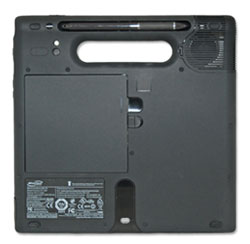 With the new i7 processor, the F5v flies, and it's a perfect match with Windows 7. Gone are all the occasional lags and pokiness of older versions. The F5v does have a small fan neatly built into the upper left corner. It rarely comes on and runs extremely quietly. The F5v heats up much less than we expected, and less than the older machine. With the new i7 processor, the F5v flies, and it's a perfect match with Windows 7. Gone are all the occasional lags and pokiness of older versions. The F5v does have a small fan neatly built into the upper left corner. It rarely comes on and runs extremely quietly. The F5v heats up much less than we expected, and less than the older machine.
The battery is recessed into the backside of the F5v (see picture to the right). It is held in place with a simple springloaded lever that opens a bit too easily for my taste. The battery is now hot-replaceable.
To activate the primary camera you push a small button on the right side. It takes about two seconds for the camera to be ready. Push the camera button again to take a picture. There is a small illuminator that can help in low light conditions. Unfortunately, the string tether for the pen is still anchored within an inch of the lens. If you use the tether it'll get in the way unless you consciously keep it out of the way.
The fingerprint scanner is also located on the right side. It is small and innocuous, and its position on the side makes scans simple.
A small button on the top right of the F5 activates RFID and/or the bar code scanner.
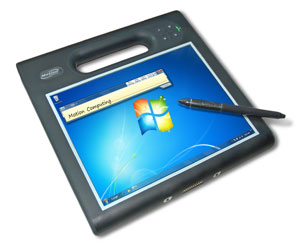 The "Motion Dashboard" is one of those handy utilities fairly common to tablet computers where you don't have a keyboard to quickly do things. The Motion Dashboard handles display settings, audio settings, pen and tablet settings, wireless, power options, and security.
The "Motion Dashboard" is one of those handy utilities fairly common to tablet computers where you don't have a keyboard to quickly do things. The Motion Dashboard handles display settings, audio settings, pen and tablet settings, wireless, power options, and security.
Like on a digital camera, almost all hardware buttons are combined in a small area that includes a navigation diamond and four buttons. Hitting "A" searches for RFID tags. Hitting the "B" button does a barcode scan.
The F5 doesn't have any expansion slots. The addition of a USB port is good news for most users. The location of the port (underneath a rubber plug next to the power jack) means that some USB keys don't fit.
Having been in the slate computer market for a good number of years now, Motion understands slate-specific and slate-optimized software better than most. F5 users should make an effort to investigate all the pen-centric utilities and applications that are either on the device, come with Windows 7, or are available via Motion and from other sources.
Summary: Motion Computing F5v
The 2010 version of Motion Computing's F5 "field tool" has received a major, and I mean MAJOR, power boost thanks to a switch to one of Intel's new Core i7 processors. The performance difference is massive and readily noticeable in almost every aspect. Our benchmarks show an overall 2.2x improvement over the predecessor model. 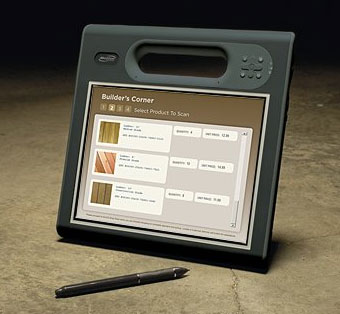 Most amazingly, even with this much more powerful processor and the same size battery, battery life has improved, rather than gone down. It's not a large battery, though, and so don't expect more than four hours or so, but the battery is now hot-swappable, another major improvement. Most amazingly, even with this much more powerful processor and the same size battery, battery life has improved, rather than gone down. It's not a large battery, though, and so don't expect more than four hours or so, but the battery is now hot-swappable, another major improvement.
The F5's Hydis AFFS+ display remains stunning. The screen is perfectly readable from any angle and any direction, without any color shifts whatsoever. Outdoor viewability is excellent, and the screen is very bright and vibrant. The new version now comes standard with "Gorilla glass," a special glass that is four times as break-resistant than the old display, and is also much less smudge- and fingerprint-prone.
The now much faster F5 remains handy, competent and rugged enough to make you forget that the platform was originally conceived as a medical tablet to be used in clinical environments. A lot of the qualities that matter there (light weight, carry handle, scanner, RFID, easy to clean, etc.) are also appreciated in a mobile field computer. And there's finally a USB port for those who need it!
With this latest version of the F5, Motion has significantly reduced our wish list. We'd still like to see a dual-mode digitizer (or maybe a capacitive multi-touch screen) at least as an option, and perhaps an SDHC card slot. And IP65 sealing should be obtainable. Else, while it may look almost exactly the same, the 2010 Motion F5v is a MUCH improved machine and eminently suitable for any number of jobs out there in the field.
– Conrad H. Blickenstorfer
|
Motion Computing F5v Specifications
|
| Added/changed |
Added 8/05/2008; updated 9/15/2009 for 2009 version; updated 5/17/2010 for 2010 F5v version
|
| Type |
Rugged Tablet PC slate
|
| Processor |
Intel Core i7 640UM 1.20GHz, max Turbo Boost 2.266GHz, 4MB L3 "smart" cache, or
Intel Core i7 520UM 1.06GHz, max Turbo Boost 1.866GHz, 3MB L3 "smart" cache
|
| Chipset |
Mobile Intel QM57 Express |
| Graphics |
Integrated |
| OS |
Windows 7 (XP Tablet PC Edition available via downgrade from Windows 7 or Vista) |
| Memory |
1GB to 4GB 800MHz DDR3 (specify at time of order) |
| Display |
10.4" XGA (1024 x 768) TFT with View Anywhere display technology (optional), LED backlight, and Gorilla glass display protection |
| Slots |
None |
| Digitizer/Pens |
Wacom/1 |
| Keyboard |
external option |
| Storage |
160GB 1.8" hard disk; optional 64GB Solid State Drive |
| Housing |
Magnesium-alloy internal frame, chemical-resistant resin upper faceplate and lower backplate, overmolded with elastomer |
| Temperature |
41-104 degrees F (5-40 degrees Celsius) |
| Enclosure Class |
IP54 |
| Humidity |
8-80% without condensation |
| Altitude |
Operating: Sea level to 15,000 feet |
| Drop |
can handle 26 drops three feet |
| Size |
10.0" x 10.0" x 0.95" |
| Weight |
3.3 pounds incl. battery pack |
| Power |
11.1V 4,000mAh 44.4 WHr Lithium-Ion ("approximately 3-4 hours"), hot-swappable |
| Communication |
Intel Centrino Advanced-N 6200 802.11a/b/g/n, Bluetooth Class 2.1 + EDR; optional integrated Gobi 2000 (with GPS) |
| Interface |
1 USB 2.0 port, Fingerprint Reader, 2 mic, docking connector; optional: 1.3mp front-facing web camera, 3-megapixel rear-facing documentation camera, 13.56MHz RFID reader, 13.56MHz RFID HF, 1D/2D barcode scanner |
| Dock |
10/100 LAN, 3 USB 2.0, VGA, charging bay |
| Warranty |
3 year field-ready warranty |
| Price |
starting at US$2,400 (est) |
| Motion website |
Motion Computing |
| Contact |
1-866-682-2538 |
|
|



